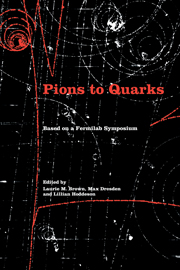Book contents
- Frontmatter
- Contents
- List of contributors
- Foreword by Leon M. Lederman
- Editors' acknowledgments
- Photographs of the symposium
- List of abbreviations
- List of notation
- I Introduction
- II Particle discoveries in cosmic rays
- III High-energy nuclear physics
- IV The new laboratory
- V The strange particles
- 19 The hydrogen bubble chamber and the strange resonances
- 20 A particular view of particle physics in the fifties
- 21 Strange particles
- 22 Strange particles: production by Cosmotron beams as observed in diffusion cloud chambers
- 23 From the 1940s into the 1950s
- VI Weak interactions
- VII Weak interactions and parity nonconservation
- VIII The particle physics community
- IX Theories of hadrons
- X Personal overviews
- Name index
- Subject index
19 - The hydrogen bubble chamber and the strange resonances
Published online by Cambridge University Press: 07 May 2010
- Frontmatter
- Contents
- List of contributors
- Foreword by Leon M. Lederman
- Editors' acknowledgments
- Photographs of the symposium
- List of abbreviations
- List of notation
- I Introduction
- II Particle discoveries in cosmic rays
- III High-energy nuclear physics
- IV The new laboratory
- V The strange particles
- 19 The hydrogen bubble chamber and the strange resonances
- 20 A particular view of particle physics in the fifties
- 21 Strange particles
- 22 Strange particles: production by Cosmotron beams as observed in diffusion cloud chambers
- 23 From the 1940s into the 1950s
- VI Weak interactions
- VII Weak interactions and parity nonconservation
- VIII The particle physics community
- IX Theories of hadrons
- X Personal overviews
- Name index
- Subject index
Summary
I have been out of high-energy physics for some twenty years, and to get myself back into the mood of a particle physicist, I would like to quote some recent remarks by Carlo Rubbia:
Detectors are really the way to express yourself. To say somehow what you have in your guts. In the case of painters, it's painting. In the case of sculptors, it's sculpture. In the case of experimental physicists, it's detectors. The detector is the image of the guy who designed it.
I've never heard it expressed so well, but I'd like to add that particle physics has always been done by a triad of equally important professionals: accelerator builders, experimental physicists, and theoretical physicists. I'll have some comments at the end on how I hope the members of the triad will interact in the future. I have been a member of the first two categories, but never of the third.
My ten years in the bubble-chamber trenches (also discussed by Peter Galison in Chapter 14), the most exciting period in my life, started at the 1953 Washington meeting of the American Physical Society (APS), when I met Donald Glaser. He showed me his first cosmic-ray tracks in a tiny bubble chamber (1 × 2 cm) filled with ether. I had been unsuccessfully racking my brain to find an appropriate detector for the Bevatron, which was about to be turned on. It was immediately clear to me that Glaser's chamber filled the bill exactly – if it could be made to work with liquid hydrogen, and if it would operate in large enough sizes.
- Type
- Chapter
- Information
- Pions to QuarksParticle Physics in the 1950s, pp. 299 - 306Publisher: Cambridge University PressPrint publication year: 1989
- 1
- Cited by

